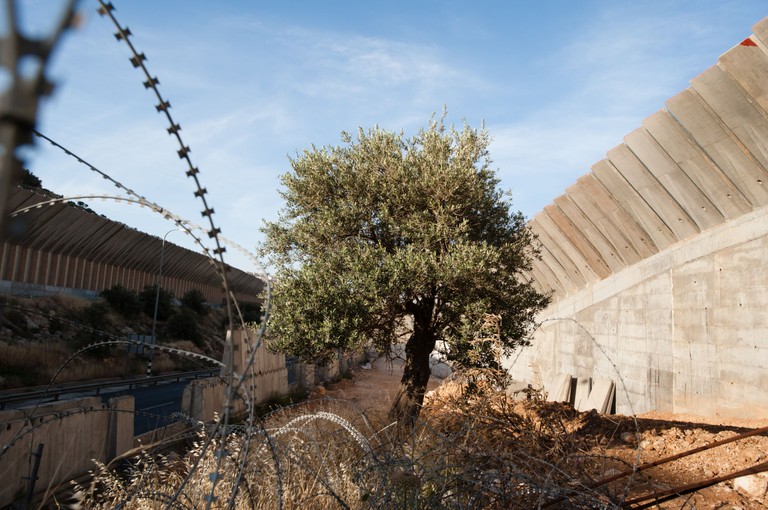The conflict in the Middle East, and its far-reaching history
As part of ERINNERN:AT's web dossier on October 7th and the war in the Middle East, the following article provides an overview of the history of the conflict. This text was first published in the polis aktuell 5/2022 "Middle East - History. Conflict. Perceptions". The text was updated for the dossier by the author Steffen Hagemann.
The conflict in the Middle East is one of the longest-running international conflicts; it has attracted particular attention due to its historical nature, the recurring outbreak of violence, the reference to the holy sites of the three world regions and its sheer acuteness of emotionality. At its core, it concerns the conflict between Israelis and Palestinians and their claim to the same territory, but it is also embedded in a much broader, Israeli-Arab context. A look at the history of the Israeli-Palestinian conflict also reveals that it encompasses an ethno-nationalist and a religious dimension, in addition to vying by all parties for a territorial claim. This complexity – which also affects the identity and legitimacy of both sides – renders conflict resolution difficult.
Historical genesis: Zionism and the founding of the state
The conflict began before the state of Israel was founded. At the end of the 19th century, political Zionism emerged in Europe, which adopted the ideas of European nationalism and called for the establishment of a Jewish national home in Palestine. In view of prevailing anti-Semitism in Europe, a state with a Jewish majority should offer protection from persecution and discrimination. The Zionist immigrants who arrived in Palestine – which was administered by Great Britain from 1920 – acquired land for this purpose and established their own institutions. The choice of Palestine was by no means coincidental; rather, the Zionist movement saw immigration to Palestine as a return to the homeland of the Jewish people, from which they had been expelled after the destruction of the Second Temple. The local Arab population increasingly found itself in conflict with the immigrants over building land, agricultural land and other resources. From their point of view, it was a process of colonisation that disregarded the legitimate claims of the local population. This led to conflicts between the Arab population, Jewish immigrants and the British Mandate, which entailed increasing levels of violence in the 1930s. In view of the upsurge in violent altercations, the UK finally turned to the United Nations for mediation. A special committee travelled to the region, and the majority spoke out in favour of dividing Palestine into two states. This recommendation was utlimately followed by the UN General Assembly in November 1947, partly against the votes of the Arab countries. In addition to the disputed historical and religious claims of the conflicting parties, Resolution 181 afforded both the Jewish and the Arab side legitimisation of their claims under international law. Even at this stage, however, the difficulties of a split were becoming apparent: a complete separation of the population groups is barely possible, Jerusalem would be placed under international administration as a place of religious significance for both sides, and the exact course of the border remained disputed. The Arab side rejected the decision as unjust. The Zionist movement was also not satisfied with the border as it stood, but it was able to achieve the central goal of establishing a state and, therefore, agreed to the plan. At the end of the British Mandate, David Ben Gurion proclaimed the State of Israel on 14 May 1948. An alliance of five Arab states then attacked Israel. The war is referred to in Israel as the War of Independence and ended with the state’s self-assertion and ceasefire lines that would go on to define the internationally recognised territory of Israel. For the Palestinian side, on the other hand, the Arab defeat is remembered as the Nakba (Arabic for catastrophe), particularly because of the expulsion and flight of approximately 700,000 Palestinians. There remains no permanent solution for these refugees to this day.
Course of the conflict: Interstate wars and Palestinian resistance
The founding of the State of Israel marked the beginning of decades of interstate conflict, with a total of six international wars being fought between Israel and its neighbours (1948, 1956, 1967, 1973, 1985, 2006). The war of 1967, in which Israel was able to achieve far-reaching territorial gains, was particularly momentous. Israel became an occupying power and, from then on, controlled the Palestinian population in East Jerusalem, the West Bank and the Gaza Strip – in addition to the Sinai and the Golan. In response to the war, the United Nations called for the withdrawal of Israeli troops from (the) occupied territories in Resolution 242 and, at the same time, reaffirmed the right of all states – including Israel – to live within secure and recognised borders. However, a lasting peace was not the result.
Following the defeat in 1967, the political constellation in the Middle East gradually changed. Some Arab states were interested in resolving the conflict with Israel. The 1973 war thus initiated the first peace process in the Middle East: the initial military success racked up by the Egyptian armies had made negotiations between Israel and Egypt possible, which ultimately led to Israel’s withdrawal from the Sinai and the first peace treaty between Israel and an Arab state. Simultaneously, the Palestinians began to organise themselves in the Palestine Liberation Organisation (PLO) – founded in 1964 – in order to achieve their objective of national self-determination.
The far-reaching terrorist attacks by the PLO in the 1970s brought the Palestinians international attention, but delegitimised their cause in the eyes of the world. In December 1987, the local population in the occupied territories took the protest into their own hands and organised a largely civil and local form of resistance against the Israeli occupation. The exiled PLO took the lead in the uprising and demanded a Palestinian state in the territories occupied by Israel on the basis of UN Resolutions 181 and 242. At the same time, the Islamist Hamas movement was founded, which called for the “liberation” of the entire historical Palestine.
Failed peace negotiations
The end of the Cold War opened a window for multilateral and bilateral peace negotiations. The signing of the Israeli-Palestinian Declaration of Principles in 1993 marked the beginning of the so-called “Oslo Accords”, the centrepiece of which was the mutual recognition of the state of Israel and the PLO. It was also agreed that Israel would gradually withdraw from parts of the occupied territories and transfer political responsibilities to the newly established Palestinian Authority. However, the contentious issues of borders, the future of the settlements, the status of Jerusalem and the refugee issue were ignored entirely. Today, the Oslo Accords is considered a failure, partly because there were no sanction mechanisms to tackle instances of non-compliance with the commitments, and opponents of political compromise used the long interim period to torpedo the peace process with acts of terror and the assertion of their own narrative.
In Israeli society, the violence of the Second Intifada has led to a loss of faith in a negotiated settlement; on the Palestinian side, the ongoing construction of settlements and the continuing occupation have undermined the hope of a peace agreement and the establishment of a state of their own. The brutal terrorist attacks by Hamas on Israel on October 7th, 2023 demonstrated that these developments have strengthened those forces that reject compromise and fundamentally reject the claims of the other side. The Hamas attacks and the subsequent Israeli war in the Gaza Strip have caused traumatisation and insecurity in Israeli and Palestinian society, thereby making it difficult to find a solution to the conflict.
The author
Dr Steffen Hagemann is a research assistant at the Technical University of Kaiserslautern in the Department of Political Science. He studied political science, as well as peace and conflict research at the Universities of Marburg, Tel Aviv and FU Berlin. Steffen Hagemann was head of the Tel Aviv office of the foundation, Heinrich-Böll-Stiftung, from 2018 to 2022, and is the author of numerous publications on the Middle East conflict.




